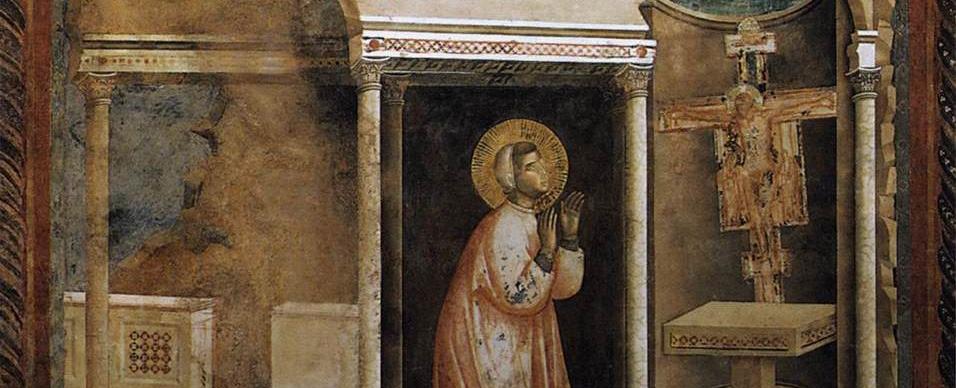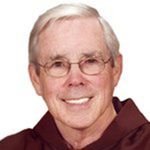Francis and the San Damiano Cross

This blog continues our Lent 2021 series of reflections on the Franciscan Intellectual-Spiritual Tradition by a variety of women and men Franciscans.
It might be in the church or the chapel or the entrance area or the dining room. If you are at a Franciscan place, sooner or later you are very likely to encounter a San Damiano cross. In both a technical and a popular sense, this cross can be called a Franciscan icon. In the technical sense, it is a product of Eastern Christian theology and spirituality. In a popular sense, it is a symbol of the conversion of Francis and of his mission in the Church.
“Repair my house”
Near the beginning of his conversion, Saint Francis used to pray in the small chapel of San Damiano, a short distance down the hill from Assisi. One day, according to the sources, Christ spoke to Francis from the cross hanging there: “Francis, go repair my house, which, as you can see, is falling completely to ruin.” We know that Francis began by taking this literally, but later realized that the house of Christ was a lot more than that. The remainder of his life would be spent responding to that command.
Praying before a Crucifix
What exactly Francis prayed during those early days, before the San Damiano cross, we do not know for sure, but perhaps we do have a hint. Tradition has given us a simple “Prayer before a Crucifix.” Almost all the manuscripts that preserve this indicate it has its origin at the foot of the crucifix in the church of San Damiano.
Most high, glorious God, enlighten the darkness of my heart
and give me true faith, certain hope, and perfect charity, sense and knowledge, Lord,
that I may carry out Your holy and true command.
Looking closer at the San Damiano cross
We can well imagine that Francis prayed before this cross with great attention and devotion, but what about us? Can we say the same? In fact, we can become so used to seeing this cross that we do not in fact really notice it that much at all. Perhaps, in the context of Holy Week, we can pause and take a closer look. Our meditation will proceed in three stages. We will begin with the large and central figure of Christ; then we will move to the midsized community of disciples gathered under his arms; finally, we will look at the small figures located at the bottom, along the sides, and at the top of the cross.
Depicting Jesus as king
Jesus is depicted as a king enthroned upon the cross. The shadow in front of his face recalls “the glory of God” in the Old Testament that overshadows Mt. Sinai, the tent in the wilderness, and enters the temple—all places where God is present in the midst of Israel. Jesus then is the presence of God in our midst; he looks out from the cross peacefully and serenely. He wears the white linen “ephod,” the garment of the priest with its gold thread. As a priest, Jesus sacrifices and intercedes on our behalf.
An inclusive community under Jesus’ arms
Assembled under the arms of Jesus, we find a community of nine persons: Jesus’ mother and the Beloved Disciple, here identified as the apostle John; two Jewish woman, Mary Magdalene and Mary, mother of James. In addition, we find some Gentiles, a centurion who has come to Jesus to heal his son, and looking over his shoulder, the face of his healed son and the foreheads of three others of the household who have come to believe. This is an inclusive community of Jews and Gentiles, women and men, young and old. The bright light of Christ shines behind them, and blood from his hands and side drips onto them; they are to be nourished by his blood. In the Synoptic Gospels, all bystanders are mentioned as being at a distance. Following the clue in John’s Gospel (19:25), the artist has brought them all near. The Son of Man, lifted up on the cross, has begun already to draw all things to himself (John 12:32-24).
Examining the cross’s figures
The figures of the bottom panel are unclear; an educated guess would see here perhaps a Last Supper scene. Moving up the cross, we see a rooster crowing, recalling the betrayal of Peter; then a Roman and Jewish leader, recalling that Jesus was put to death by Jewish and Roman authorities. Three sets of two angels recall the two angels at the empty tomb on Easter morning; then Jesus, as king, ascends to heaven where ten angels (five on either side) welcome him; there he is seated at the right hand (visible) of the Father.
Visual clues to key moments in the passion of Jesus
We can see as we look at each figure and then move, step by step up the cross, that these figures are visual clues or representations that call to mind key moments in the passion of Jesus. They take us in a narrative fashion through a meditation on Jesus’ arrest, crucifixion, resurrection, and ascension to the Father’s right hand.
Embodying poverty and humility
Michael Guinan, OFM
Professor Emeritus of Old Testament and Semitic Languages
Michael Guinan, OFM, PhD, a priest of the OFM St. Barbara Province, is professor emeritus of Old Testament and Semitic Languages at the Franciscan School of Theology in San Diego, CA. Though retired, he still teaches occasional courses for FST. In addition to FST, he has taught at St. Bonaventure University, NY; St. Patrick’s Seminary, Menlo Park, CA; and Our Lady of the Angels Franciscan Seminary in Manila, Philippines. He is a contributor to the New Jerome Biblical Commentary, the Collegeville Bible Commentary series, and The Message of Biblical Spirituality series. He has contributed articles to the Anchor Bible Dictionary, the New Interpreter’s Dictionary of the Bible, as well as to St. Anthony Messenger, and the popular Catholic Update series. In addition to these writings, he has recorded 10 audio courses, covering different parts of the Old Testament, for Learn25.com (formerly NowYouKnowMedia).

